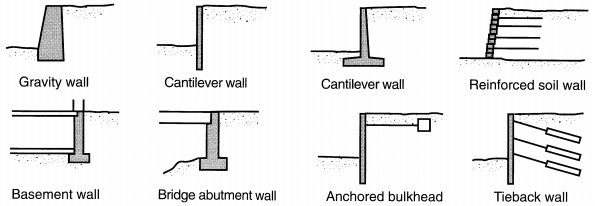Retaining walls are relatively rigid walls used for supporting the soil mass laterally so that the soil can be retained at different levels on the two sides. Retaining walls are structures designed to restrain soil to a slope that it would not naturally keep to (typically a steep, near-vertical or vertical slope). Earth retaining structures, such as retaining walls, bridge abutments, quay walls, anchored bulk-heads, braced excavations, and mechanically stabilized walls, are used throughout seismically active areas. They frequently represent key elements of ports and harbors, transportation systems, lifelines, and other constructed facilities.
The most important consideration in proper design and installation of retaining walls is to recognize and counteract the tendency of the retained material to move downslope due to gravity. This creates lateral earth pressure behind the wall which depends on the angle of internal friction (phi) and the cohesive strength (c) of the retained material, as well as the direction and magnitude of movement the retaining structure undergoes.
Lateral earth pressures are zero at the top of the wall and – in homogenous ground – increase proportionally to a maximum value at the lowest depth. Earth pressures will push the wall forward or overturn it if not properly addressed. Also, any groundwater behind the wall that is not dissipated by a drainage system causes hydrostatic pressure on the wall. The total pressure or thrust may be assumed to act at one-third from the lowest depth for lengthwise stretches of uniform height.
As an example, the International Building Code requires retaining walls to be designed to ensure stability against overturning, sliding, excessive foundation pressure and water uplift; and that they be designed for a safety factor of 1.5 against lateral sliding and overturning.
TYPES OF RETAINING WALLS:
The problem of retaining soil is one of the oldest in geotechnical engineering; some of the earliest and most fundamental principles of soil mechanics were developed to allow rational design of retaining walls. Many different approaches to soil retention have been developed and used successfully. In recent years, the development of metallic, polymer, and geotextile reinforcement has led to the development of many innovative types of mechanically stabilized earth retention systems.
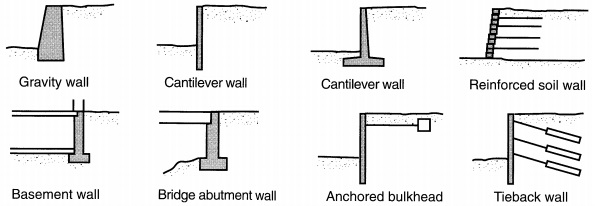
Retaining walls are often classified in terms of their relative mass, flexibility, and anchorage conditions. Gravity walls are the oldest and simplest type of retaining wall.
- Gravity walls are thick and stiff enough that they do not bend; Gravity walls are the earliest known retaining structures. They are built from solid concrete or rock rubble mortared together; The lateral forces from backfill are resisted by the weight of wall itself, and due to their massive nature, they develop little or no tension. Therefore, they are usually not reinforced with steel. Gravity walls are economical for heights up to 3m (10 feet). their movement occurs essentially by rigid-body translation and/or rotation. Certain types of composite wall systems, such as crib walls and mechanically stabilized walls, are thick enough that they bend very little and consequently are often designed as gravity walls (with appropriate consideration of internal stability).

- Cantilever walls, which bend as well as translate and rotate, rely on their flexural strength to resist lateral earth pressures. The actual distribution of lateral earth pressure on a cantilever wall is influenced by the relative stiffness and deformation of both the wall and the soil. Cantilever walls are built of reinforced concrete and are typically composed of a horizontal footing and a vertical stem wall. The weight of the soil mass above the heel helps keep wall stable. Cantilever walls are economical for heights up to 10 m (32 feet). Typical costs of cantilever walls in 2005 is approximately $80/sf.
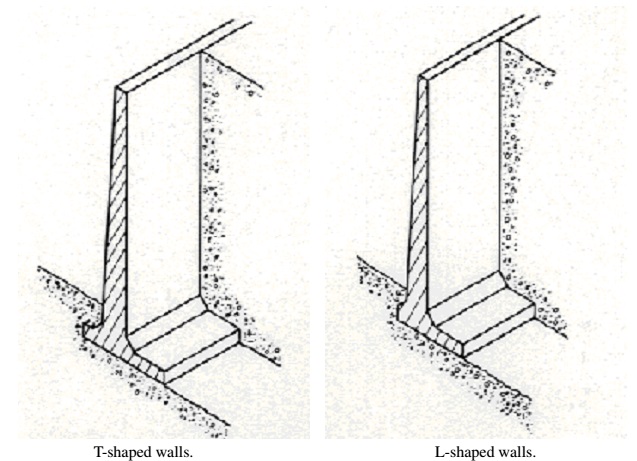
- Mechanically Stabilized Earth Walls (MSE Walls): These walls are among the most economical, and most commonly constructed. Contrary to other types, the MSE walls are supported by the soil, and not the other way around. They are supported by selected fills (granular) and held together by reinforcements, which can be either metallic strips or plastic meshes. Typical prices range of mechanically stabilized (MSE) walls is from $25/sf to $45/sf. There are three categories of MSE walls: 1) Panel walls, 2) Concrete Block Walls, and 3) Temporary Earth Walls.
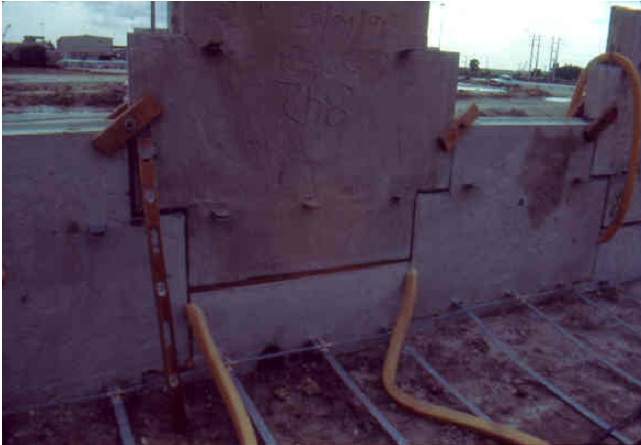
- Sheet pile walls: Used to build continuous walls for waterfront structures and for temporary construction wall; heights > 6 m if used with anchors. Can be made of steel, plastics, wood, pre-cast concrete.
The advantages of using steel sheet-piling: 1. Provides higher resistance to driving stresses; 2. Is of an overall lighter weight; 3. Can be reused on several projects; 3. Can be reused on several projects; 4. Provides a long service life above or below the water table; 5. Easy to adapt the pile length by either welding or bolting; and 6. Their joints are less apt to deform during driving.
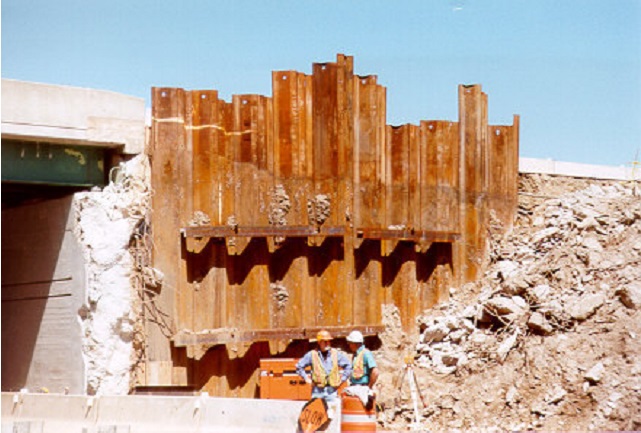
- Braced walls are constrained against certain types of movement by the presence of external bracing elements. In the cases of basement walls and bridge abutment walls, lateral movements of the tops of the walls may be restrained by the structures they support.
- Tieback walls and anchored bulkheads are restrained against lateral movement by anchors embedded in the soil behind the walls. The provision of lateral sup-port at different locations along a braced wall may keep bending moments so low that relatively flexible structural sections can be used.
- Crib walls are made up of interlocking individual boxes made from timber or pre-cast concrete. The boxes are then filled with crushed stone or other coarse granular materials to create a free-draining structure. There are two basic types of crib wall: Timber and Reinforced pre-cast concrete.

TYPES OF RETAINING WALLS IN TERM OF MATERIAL:
- Wood sheets;
- Steel and plastic interlocking sheets;
- Reinforced concrete sheets;
- Precast concrete elements (crib walls and block walls);
- Closely spaced in-situ soil-cement piles;
- Wire-mesh boxes (gabbions); -Wire-mesh boxes (gabbions); and
- Anchors into the soil or rock mass (soil nailing).
TYPES OF RETAINING WALL FAILURES:
To design retaining walls, it is necessary to define “failure” and to know how walls can fail. Under static conditions, retaining walls are acted upon by body forces related to the mass of the wall, by soil pressures, and by external forces such as those transmitted by braces. A properly designed retaining wall will achieve equilibrium of these forces without inducing shear stresses that approach the shear strength of the soil. During an earthquake, however, inertial forces and changes in soil strength may violate equilibrium and cause permanent deformation of the wall. Failure, whether by sliding, tilting, bending, or some other mechanism, occurs when these permanent deformations become excessive. The question of what level of deformation is excessive depends on many factors and is best addressed on a site-specific basis.

Gravity walls usually fail by rigid-body mechanisms such as sliding and/or overturning or by gross instability. Sliding occurs when horizontal force equilibrium is not maintained (i.e., when the lateral pressures on the back of the wall produce a thrust that exceeds the available sliding resistance on the base of the wall). Overturning failures occur when moment equilibrium is not satisfied; bearing failures at the base of the wall are often involved. Gravity walls may also be damaged by gross instability of the soils behind and beneath them. Such failures may be treated as slope stability failures that encompass the wall. Composite wall systems, such as crib walls, bin walls, and mechanically stabilized walls, can fail in the same ways or by a number of internal mechanisms that may involve shearing, pullout, or tensile failure of various wall elements.

Cantilever walls are subject to the same failure mechanisms as gravity walls, and also to flexural failure mechanisms. Soil pressures and bending moments in cantilever walls depend on the geometry, stiffness, and strength of the wall—soil system. If the bending moments required for equilibrium exceed the flexural strength of the wall, flexural failure may occur. The structural ductility of the wall itself may influence the level of deformation produced by flexural failure.

Braced walls usually fail by gross instability, tilting, flexural failure, and/or failure of bracing elements. Tilting of braced walls typically involves rotation about the point at which the brace acts on the wall, often the top of the wall as in the cases of basement and bridge abutment walls. Anchored walls with inadequate penetration may tilt by “kicking out” at their toes. As in the case of cantilever walls, anchored walls may fail in flexure, although the point of failure (maximum bending moment) is likely to be different. Failure of bracing elements can include anchor pullout, tierod failure, or bridge buckling. Backfill settlements can also impose additional axial and transverse loading on bracing elements such as tierods and tiebacks.
